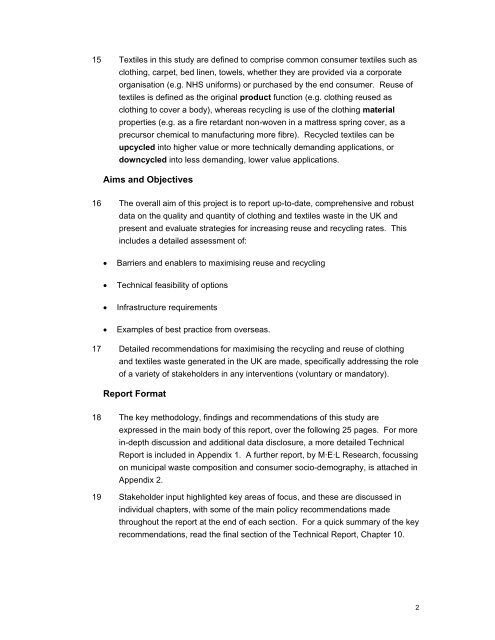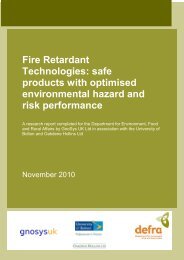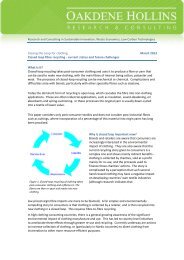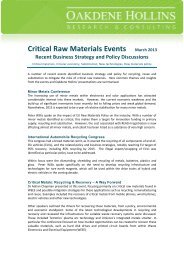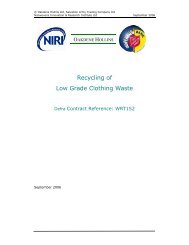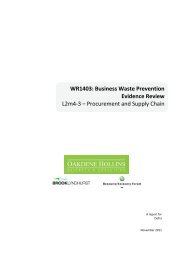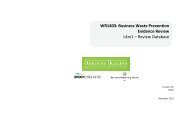Maximising Reuse and Recycling of UK Clothing ... - Oakdene Hollins
Maximising Reuse and Recycling of UK Clothing ... - Oakdene Hollins
Maximising Reuse and Recycling of UK Clothing ... - Oakdene Hollins
You also want an ePaper? Increase the reach of your titles
YUMPU automatically turns print PDFs into web optimized ePapers that Google loves.
15 Textiles in this study are defined to comprise common consumer textiles such as<br />
clothing, carpet, bed linen, towels, whether they are provided via a corporate<br />
organisation (e.g. NHS uniforms) or purchased by the end consumer. <strong>Reuse</strong> <strong>of</strong><br />
textiles is defined as the original product function (e.g. clothing reused as<br />
clothing to cover a body), whereas recycling is use <strong>of</strong> the clothing material<br />
properties (e.g. as a fire retardant non-woven in a mattress spring cover, as a<br />
precursor chemical to manufacturing more fibre). Recycled textiles can be<br />
upcycled into higher value or more technically dem<strong>and</strong>ing applications, or<br />
downcycled into less dem<strong>and</strong>ing, lower value applications.<br />
Aims <strong>and</strong> Objectives<br />
16 The overall aim <strong>of</strong> this project is to report up-to-date, comprehensive <strong>and</strong> robust<br />
data on the quality <strong>and</strong> quantity <strong>of</strong> clothing <strong>and</strong> textiles waste in the <strong>UK</strong> <strong>and</strong><br />
present <strong>and</strong> evaluate strategies for increasing reuse <strong>and</strong> recycling rates. This<br />
includes a detailed assessment <strong>of</strong>:<br />
• Barriers <strong>and</strong> enablers to maximising reuse <strong>and</strong> recycling<br />
• Technical feasibility <strong>of</strong> options<br />
• Infrastructure requirements<br />
• Examples <strong>of</strong> best practice from overseas.<br />
17 Detailed recommendations for maximising the recycling <strong>and</strong> reuse <strong>of</strong> clothing<br />
<strong>and</strong> textiles waste generated in the <strong>UK</strong> are made, specifically addressing the role<br />
<strong>of</strong> a variety <strong>of</strong> stakeholders in any interventions (voluntary or m<strong>and</strong>atory).<br />
Report Format<br />
18 The key methodology, findings <strong>and</strong> recommendations <strong>of</strong> this study are<br />
expressed in the main body <strong>of</strong> this report, over the following 25 pages. For more<br />
in-depth discussion <strong>and</strong> additional data disclosure, a more detailed Technical<br />
Report is included in Appendix 1. A further report, by M·E·L Research, focussing<br />
on municipal waste composition <strong>and</strong> consumer socio-demography, is attached in<br />
Appendix 2.<br />
19 Stakeholder input highlighted key areas <strong>of</strong> focus, <strong>and</strong> these are discussed in<br />
individual chapters, with some <strong>of</strong> the main policy recommendations made<br />
throughout the report at the end <strong>of</strong> each section. For a quick summary <strong>of</strong> the key<br />
recommendations, read the final section <strong>of</strong> the Technical Report, Chapter 10.<br />
2


